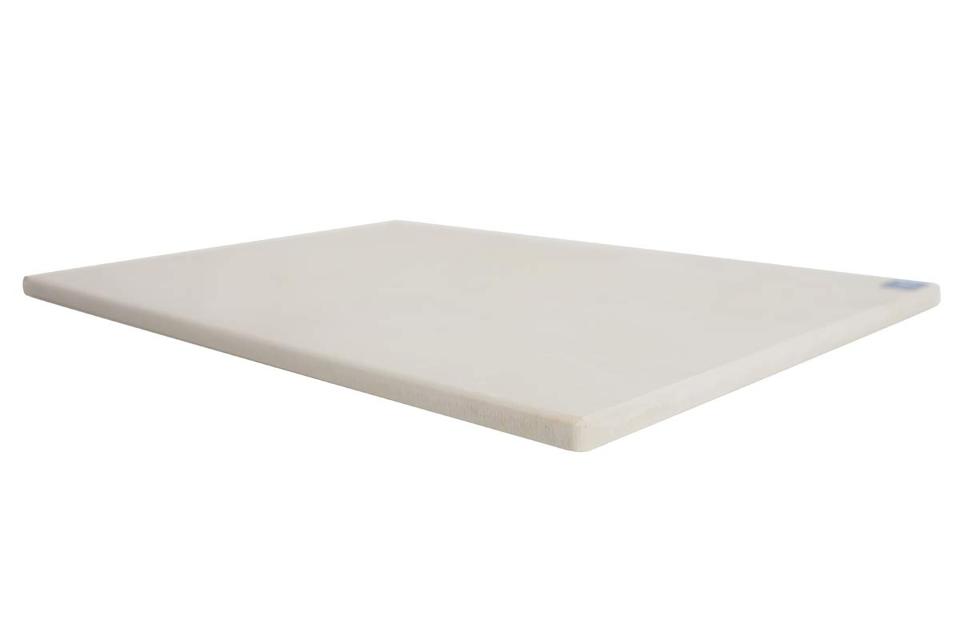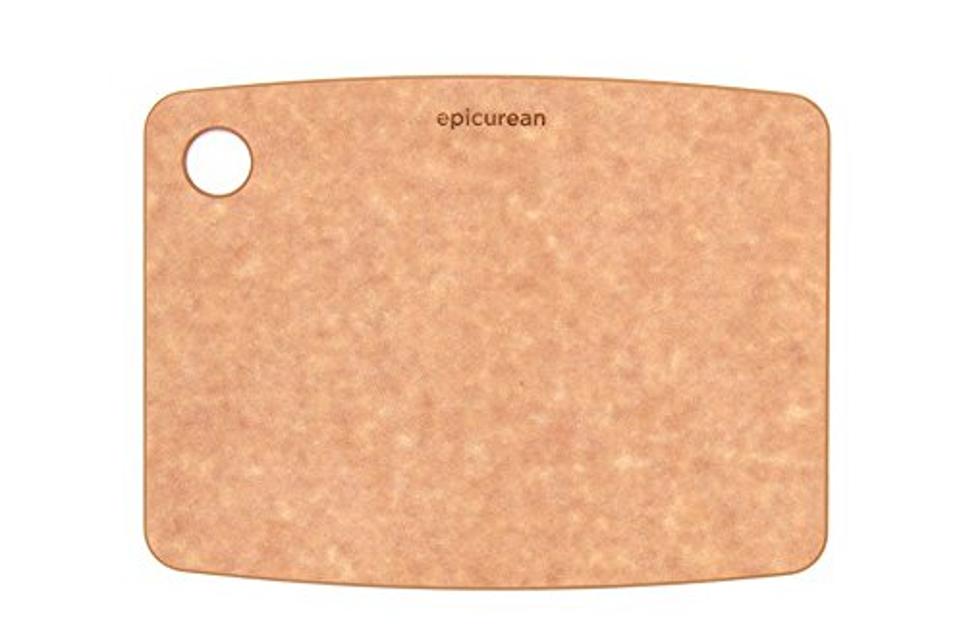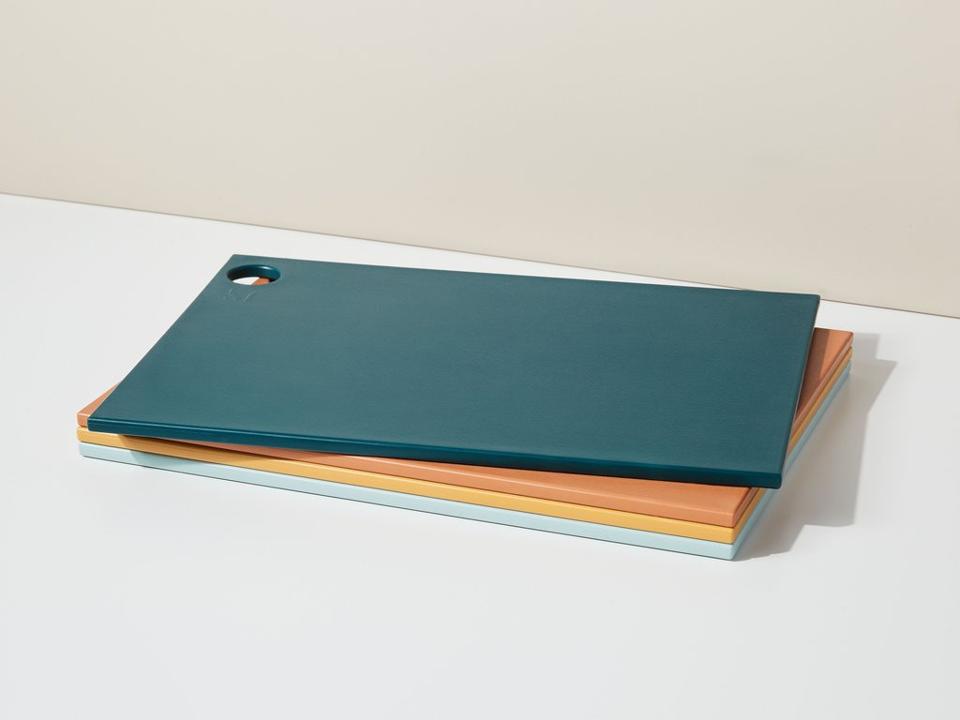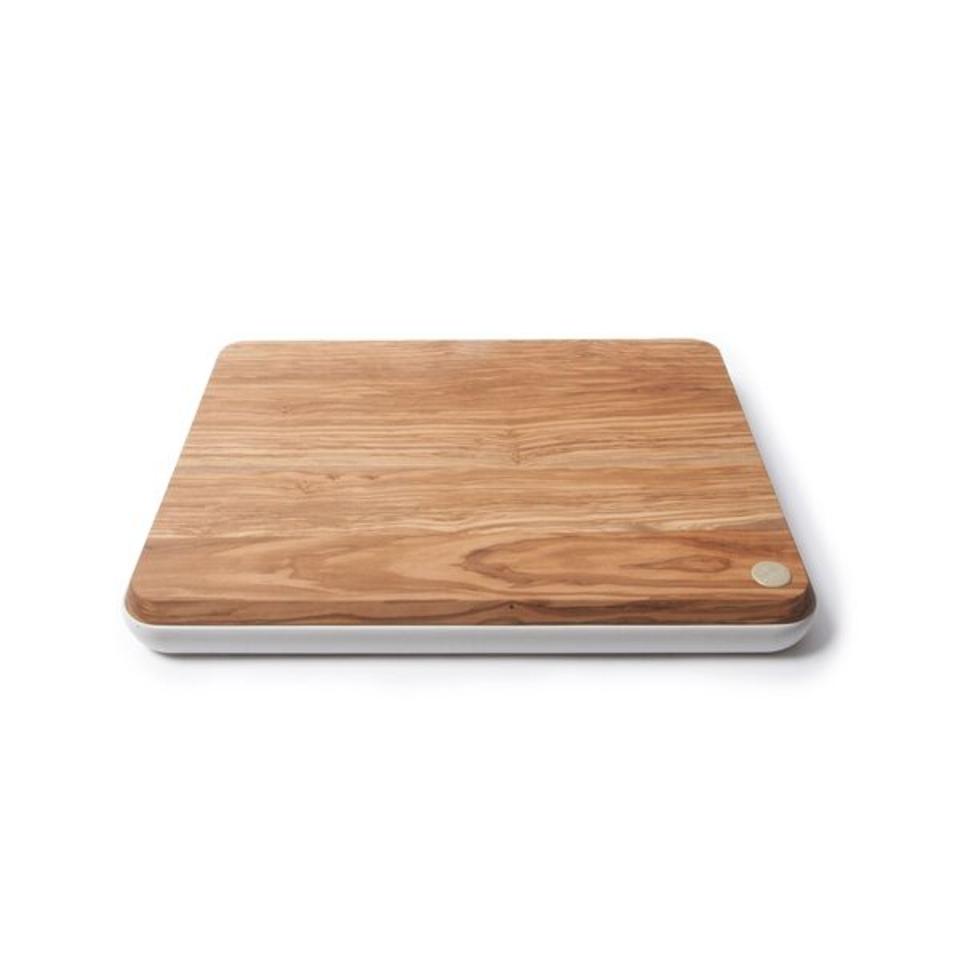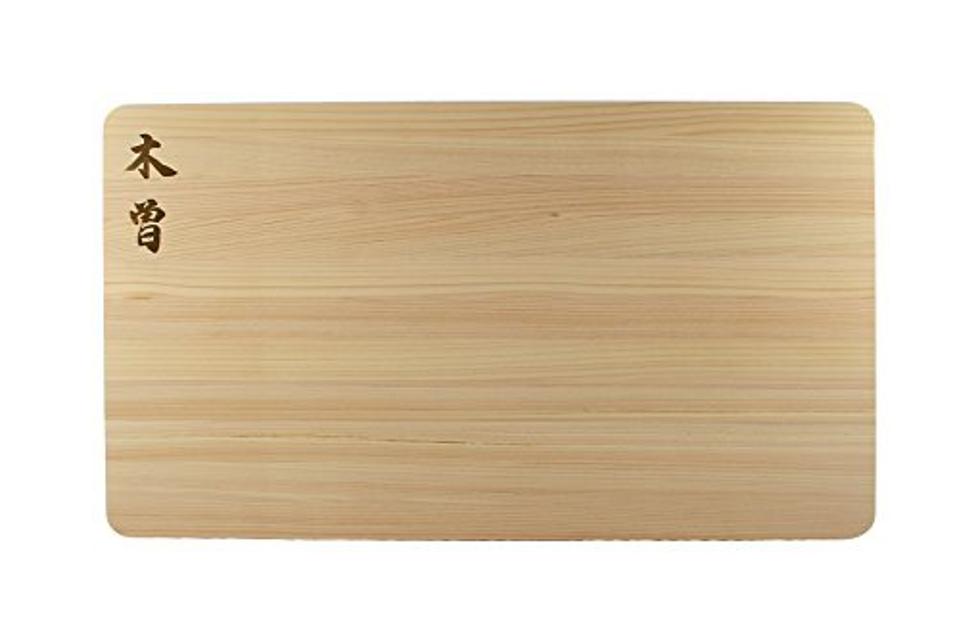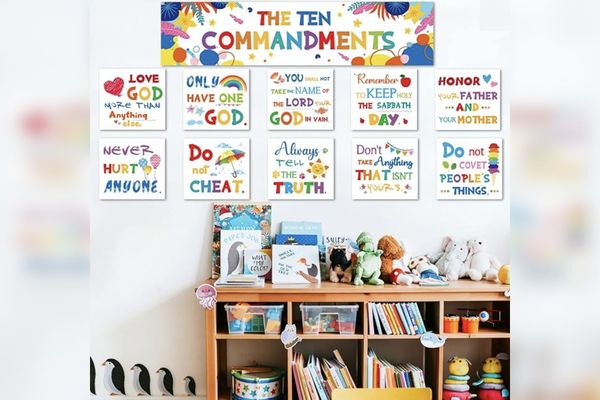If you obsess over your knives, as most chefs do, you should also care about your cutting boards. Often an afterthought in the kitchen, cutting boards prevent blades from being dulled on hard surfaces like counters or plates. They also play a key role in food sanitation. As such, a well-stocked kitchen should have several different cutting boards for the multitude of things you’ll need to cut. And while you can get a cutting board in a number of different shapes, sizes and materials, the best cutting boards allow you to cut everything from vegetables and bread to raw meat, fish and chicken safely and properly.

In terms of material, wood is a good option for a cutting board. Naturally anti-microbial and often attractive enough to be used as a serving piece, wooden cutting boards are sturdy and can last a long time if cared for properly (one pitfall of wooden cutting boards is that they’re not dishwasher safe and so need to be hand washed thoroughly to sanitize and treated regularly to prevent warping or cracking). Bamboo is another good option for a cutting board as it’s also anti-microbial, though it’s slightly harder than other wood options and a little harder on your knives as a result.
And then there’s plastic. While lots of folks think that plastic cutting board options are most sanitary because they are dishwasher safe, crevices and knife scars found in plastic cutting boards can actually trap and spread bacteria if they’re not cleaned properly. So no matter the material you choose—and different materials are good for different things—always be sure to properly clean your cutting board when you’re done using it.
Beyond that, the type of cutting board you use is a matter of preference. Tim Hollingsworth, chef and owner of Otium, CJ Boyd's and Free Play in Los Angeles likes to get pieces of wood from lumber yards and make his own. For him, the best cutting board should be durable. “I’ve had the same wood board for over 20 years now, he says. “Every once in a while I sand it down and oil it.”
And according to Tiffani Faison, the Boston-based chef and restaurateur behind Big Heart Hospitality, no matter what type of board you use, you should always invest in a cutting board mat, like the San Jamar Saf-T-Grip Board-Mate to place under it. “It lasts forever and keeps your board completely still,” she says.
Here, Hollingsworth and Faison share the boards they’ve used and loved during their culinary careers. From anti-microbial rubber to a stunning maple wood option that will last for decades, these are some of the best cutting boards to have in your kitchen.
- Best Overall Cutting Board: Notrax Sani-Tuff Premium Rubber Cutting Board
- Best Wood Cutting Board: John Boos Walnut Wood Edge Grain Reversible Round Cutting Board
- Best Eco-Friendly Cutting Board: The Epicurean Kitchen Series
- Best Cutting Board For Meat Or Fish: John Boos Maple Cutting Board with Juice Groove
- Best Plastic Cutting Board: Material Kitchen The reBoard
- Best Bamboo Cutting Board: Traeger Magnetic Bamboo Cutting Board
- Best Soft Wood Cutting Board: Hinoki Cutting Board
- Best Stain Resistant Cutting Board: Epicurean Natural Fiber Cutting Board
- Best Durable Cutting Board: Berard France Millenari Olive Wood Cutting Board
- Best Large Cutting Board: Kiso Hinoki Cutting Board
Best Overall Cutting Board
Notrax Sani-Tuff Premium Rubber Cutting Board
The Notrax Sani-Tuff Premium Rubber Cutting Board is made from an antimicrobial compound that is easier on your knife and holds less bacteria than any other cutting board, says Faison. “I haven't seen them gain traction outside of professional kitchens and I've always wondered why,” she says. “The board is great for cutting anything—vegetables, meat, whatever. It cleans easily and can take a good bleaching. They don't chip or break and they last forever.”
Best Wood Cutting Board
John Boos Walnut Wood Edge Grain Reversible Round Cutting Board
Both Hollingsworth and Faison are fans of John Boos’ wood cutting boards. “I have been using this brand for many years and just love its durability, look and feel,” says Hollingworth. Faison says they’re great for everyday use, but she also loves the look of the boards. Hard woods, like maple and walnut, are better at resisting bacteria. John Boos makes an 18-inch reversible round walnut board (which also comes in cherry and maple) that is a workhorse in the kitchen and a stunner on the table at dinner parties.
Best Eco-Friendly Cutting Board
The Epicurean Kitchen Series
“The Epicurean Kitchen Series is an awesome cutting board made of a paper composite material (a combination of recycled paper, plastic and FSC certified papers),” says Hollingsworth. “I love using this board to cut onions, garlic or anything that would perfume your board because unlike a wood board the scent washes right off.” Available in four different sizes, Epicurean boards are dishwasher-safe and temperature resistant to 350 degrees Fahrenheit, so they’re super handy and can be used as trivets as well.
Best Cutting Board For Meat Or Fish
John Boos Maple Cutting Board With Juice Groove
“John Boos makes a reversible maple cutting board that has grooves on one side which is useful when cutting meat or fish because it catches all the juices so you avoid a big mess when moving around your board,” says Hollingsworth. Made from sustainably sourced American hardwood, it won’t blunt your knives and it’s extra thick for added stability. The other side features a flat surface so it can double as a cheese or charcuterie board.
Best Plastic Cutting Board
Material Kitchen The reBoard
One of the most sustainable plastic cutting boards, Material Kitchen’s The reBoard is made up of 75% post-consumer plastic scraps gathered from kitchen tool manufacturing and 25% sugarcane (which replaces petroleum as a structural polymer). The textured surface ensures that the board never slides when you’re using it, and unlike other plastic boards and mats that tend to cling to food bits, The reBoard is incredibly easy to clean by hand or in the dishwasher. There’s also a mini size that’s perfect for slicing fruits, dicing herbs or prepping a snack.
Best Bamboo Cutting Board
Traeger Magnetic Bamboo Cutting Board
“Traeger Grills makes a Magnetic Bamboo Cutting Board that is super handy to have when using your outdoor barbecue grill because it attaches to the shelf next to your grill,” says Hollingsworth. Made of eco-friendly bamboo, it won’t slip when you slice meat or dice veggies. You can clean it by hand washing with warm water and mild soap. And it will last longer if you occasionally rub it with mineral oil.
Best Soft Wood Cutting Board
Hinoki Cutting Board
Hinoki, or Japanese maple, is a soft wood used to construct everything from bath houses to shrines in Japanese culture. Being a soft wood, it’s gentle on knife edges. Rich in phytoncide compounds, the wood has a natural resistance to bacteria and fungus. They’re also ideal for apartments or small spaces, says Andrew Iacono, chef of Prairie Fire in Brookline, Massachusetts. “Because they’re constructed from a single piece of wood, they usually come in smaller sizes than typical cutting boards which makes them easy to store in drawers or cabinets,” he says.
Best Stain Resistant Cutting Board
Epicurean Natural Fiber Black Cutting Board
Wood and plastic easily stain when cutting items such as beets, says Iacono. He likes that a black color avoids stains but also looks great in any kitchen. This board is made from non-porous wood fiber, which has every quality you’d want in a cutting board: It won’t dull your knife, it’s heat resistant up to 350 degrees Fahrenheit, it doesn’t harbor bacteria and is dishwasher safe.
Best Durable Cutting Board
Berard France Millenari Olive Wood Cutting Board
After living in Italy for many years, Linda Hampsten Fox, chef-owner of the Bindery in Denver, became obsessed with olive wood cutting boards. “Olive wood is one of the hardest of all woods due to the slow growth of the tree,” she says. “The wood becomes tightly grained and extremely dense, which makes it durable and an ideal workhorse for the kitchen.” An added bonus, many, like this reversible olive wood board from Berard, are gorgeous and can double as a lovely cheese board or serving platter.
Best Large Cutting Board
Kiso Hinoki Cutting Board
Paul C. Reilly, chef-owner of Coperta in Denver, eats a lot of vegetables at home and likes to spread them out on a single large cutting board. This board measures 20-by-12-by-1 inch and he loves that it’s made of Japanese hinoki, a soft wood that’s gentle on the edge of his Japanese vegetable cleaver. “The wood also has a pleasant scent reminiscent of pine and the aroma intensifies when the wood gets wet,” he says.
What Type Of Cutting Board Is Best?
When it comes to chopping and dicing in the kitchen, the best cutting board is large, sturdy and easy to maintain. If you have to choose one cutting board, wood is the way to go. Wooden cutting boards are designed to endure the sharpest of knives. Plus, they’ll last you several years without having to get a replacement so it’s a worthy investment. However, a plastic cutting board is easy to clean and store and more affordable. The short answer is the best cutting board really depends on what you’re looking to get out of it.
Which Type Of Cutting Board Is The Most Hygienic?
According to the FDA, both plastic and wooden cutting boards are hygienic as long as they are cleaned often and replaced in a timely manner. Both wood and plastic have their perks when it comes 21 hygiene. Plastic can easily be placed into the dishwasher to be cleaned, however, wood is naturally anti-microbial so there’s potentially less opportunity to miss those nooks and crannies where bacteria may be collecting.
Can You Put Raw Meat On A Wood Cutting Board?
It’s commonly believed that you can’t put raw meat on a wood cutting board, but you actually can. The USDA Meat and Poultry Hotline advises that using a wood cutting board or any other non-porous cutting board is safe. However, it’s highly recommended to have one cutting board for meat and poultry and another for produce to prevent cross contamination.
